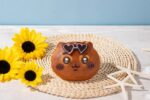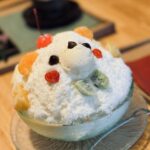
When you visit Japan, one treat you’ll see almost everywhere is soft serve ice cream (ソフトクリーム, sofuto kurīmu). While soft serve originally came from the United States in the 1930s, it was first introduced to Japan in 1951 at a summer event in Tokyo. Since then, it has become one of the country’s favorite sweets—and developed into a unique part of Japanese food culture.
Why Japanese Soft Serve is Special
- Rich Dairy Flavor 🥛
Thanks to Japan’s high-quality milk—especially from Hokkaido—Japanese soft serve has a smooth, creamy taste that many visitors say is richer than what they tried abroad. - Endless Flavors 🍵🍑🍈
Japan is famous for experimenting with flavors. Beyond vanilla and chocolate, you’ll find matcha (green tea), black sesame, sakura (cherry blossom), sweet potato, yuzu, and even wasabi! Many regions also offer seasonal and local fruit flavors, like Yubari melon from Hokkaido or peach from Okayama. - A Must at Tourist Spots 🗾
Soft serve is not just a dessert—it’s part of the travel experience. Almost every tourist spot, from mountain viewpoints to hot spring towns, has its own “local soft serve” that you can only taste there. Trying them is like collecting souvenirs in sweet form.



Where to Try It
- Hokkaido – Famous for its rich dairy and Yubari melon flavor.
- Kyoto – Matcha soft serve from Uji tea.
- Kanazawa – Try the luxurious gold leaf soft serve, covered with edible gold, which has become an Instagram sensation.
- Okinawa – Unique flavors like beni-imo (purple sweet potato).
- Rural Farms & Roadside Stations – Often use fresh milk from nearby cows.



Final Tip
Soft serve in Japan is not just a snack—it’s a cultural experience. Whether you’re walking through a historic town, hiking in the mountains, or relaxing at a seaside resort, look for the local flavor of soft serve. It’s the sweetest way to taste Japan’s regions.






